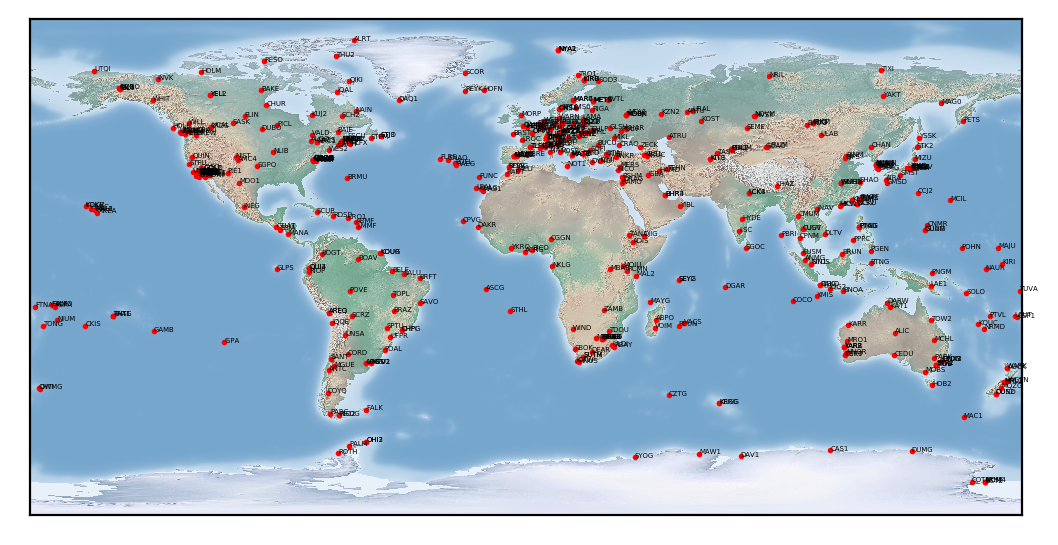Frequently Asked Questions
What is the IGS?
The IGS is a voluntary federation of many worldwide agencies that pool resources and permanent GNSS station data to generate precise GNSS products. In general, you can think of the IGS as the highest-precision international civilian GNSS community.
What isn't the IGS?
- The IGS does not manufacture or sell any equipment.
- The IGS does not offer asset tracking services (such as tracking packages, vehicles, or children).
- The IGS does not endorse equipment (there are functional requirements for equipment at IGS sites specified in the IGS Site Guidelines).
- The IGS regrets that it cannot respond to questions that relate to these topics, or are otherwise out of scope. If you are not familiar with the scope of the IGS, please read the Goals and Objectives section of the IGS Terms of Reference. We also cannot respond to general GPS/GNSS inquiries beyond providing a list of general resources. Please give us the courtesy of not sending inquiries that are not related to IGS activities.
What is the status of the GNSS constellation?
- For Beidou: China National Space Administration
- For Galileo: European Global Navigation Satellite System Agency
- For GLONASS: GLONASS center.
- For GPS: U.S Coast Guard’s Navigation Center.
- For IRNSS/NAVIC: Indian Space Research Organization
- For QZSS: Japan Aerospace Exploration Agency
What can I read to learn about GNSS?
Teunissen, Peter J.G., & Montenbruck, O. (Eds.), Springer Handbook of Global Navigation Satellite Systems (1st ed., pp. 967-982). Cham, Switzerland: Springer International Publishing. DOI: 10.1007/978-3-319-42928-1.
This book includes a full chapter on IGS and it is currently available for purchase and download on the Springer website.
Other IGS publications (particularly the most recent Annual Report) are found in our documents.
How is the IGS Funded?
Each participating organization voluntarily brings its own funding according to its own mission. These organizations tend to be public or government institutions or other research organizations. Consequently, the IGS requires redundancy and/or multi-year commitments from important components to ensure reliability. To help IGS agencies justify funding requests, we request that users include a citation when use of IGS data or products results in a publication. We suggest:
Johnston, G., Riddell, A., Hausler, G. (2017). The International GNSS Service. Teunissen, Peter J.G., &Montenbruck, O. (Eds.), Springer Handbook of Global Navigation Satellite Systems (1st ed., pp. 967-982). Cham, Switzerland: Springer International Publishing. DOI: 10.1007/978-3-319-42928-1.
The book is currently available for purchase and download on the Springer website.
What is the role of the IGS Governing Board?
The IGS is led by an international Governing Board (GB) that is comprised of seats elected by Associate Members who represent the principal IGS participants, as well as chairs of IGS Working Groups, members appointed by the Board to fill competence or geographical representation gaps, and representatives of stakeholder organizations. The GB discusses the activities of the various IGS components, sets policies and monitors the progress with respect to the agreed strategic plan and Governing Board directives.
You can learn about the current GB Members in here.
What is the IGS Central Bureau and what function does it serve?
Executive management of the IGS is carried out by the Central Bureau (CB), whose office is hosted at the NASA Jet Propulsion Laboratory (JPL), California Institute of Technology, in Pasadena, California, USA. It is funded principally by the US National Aeronautics and Space Administration (NASA), which generously contributes significant staff, resources, and coordination to advance the IGS.
The mission of the IGS CB is to provide continuous management and technological resources in order to sustain the multifaceted efforts of the IGS in perpetuity. It functions as the executive office of the Service and responds to the directives and decisions of the IGS Governing Board. The CB coordinates the IGS tracking network and operates the CB information system (CBIS), the principal information portal where the IGS web, https and mail services are hosted. The CB also represents the outward face of IGS to a diverse global user community, as well as the general public.
You can learn more about our current IGS CB Staff in here.
What are IGS Products?
IGS products are formed from a combination of independent results submitted by the IGS Analysis Centers. To the extent that the effect of data and mismodeling among different Analysis Centers are independent, properly weighted combinations of results can be superior. In this way, the IGS products benefit in precision, accuracy, stability, reliability, and robustness compared to the results of any individual AC.
A table of products with their update schedules, formats, accuracies, access details, etc. is available at IGS Products
The IGS Analysis Center Coordinator’s page is also an informative source about recent performance of the classic IGS products.
Are JPL orbits, NGS orbits, SIO orbits, etc., considered IGS orbits?
These are the submissions to the IGS combined product generated by each IGS Analysis Center (AC), but the official IGS products are the combinations formed by coordinators from the solutions submitted by each AC. IGS products can be recognized by their filenames, as detailed in the product access information.
What software, models, and conventions do the Analysis Centers use?
See the files in IGS Analysis Center Coordinator’s page, which are submitted by the ACs.
How do I use IGS products? What corrections must I apply?
See “A guide to use IGS Products” by J. Kouba
What about antenna offsets?
See “A guide to use IGS Products” by J. Kouba
How do I interpolate between points in the IGS orbits?
Here are a couple references on interpolation methods:
Hofmann-Wellenhof, Lichtenegger, and Collins, “GPS: Theory and Practice,” 5th edition, Springer (2001), p. 69.
Schenewerk, “A brief review of basic GPS orbit interpolation strategies,” GPS Solutions (2003) 6:265-267 DOI:10.1007/s10291-002-0036-0
What reference frames were used during what periods? How do I transform between them?
We recommend the following useful references:
- ITRF Transformation Parameters
- Kouba, “The GPS Toolbox ITRF Transformations,” GPS Solutions (2002) 5:88-90
- GPS Toolbox files
- Tables near the bottom of NGS’ CORS Coordinates
What types of data are available from the IGS sites?
A table outlining each data type, including sampling intervals, formats, and access details, is kept up-to-date in our IGS Products.
Do I need to cite/acknowledge the IGS?
By accessing data, products, and any other information from the IGS, users agree to appropriately cite and attribute these resources to providers and their sponsors, acknowledgment of IGS and its contributing organizations, and to adherence to professional and ethical standards. Citation information can be found at Official Citation.
What is an IGS station?
An IGS station conforms to the IGS Site Guidelines and is listed on IGS network.

What is the relation of the IGS network to regional networks like EUREF, SCIGN, CORS, etc?
These are dense regional networks composed of stations that in most cases meet the IGS Site Guidelines. They are considered to be related networks and the IGS works closely with the agencies which operate them. Typically, a subset of a regional network’s stations is designated also as IGS stations. The choice of which stations should also be IGS stations is motivated by their benefit to the IGS Products, according to location and instrumentation.
May I propose a new IGS station?
If it is expected to be beneficial to an IGS product or project, please use our Propose a New IGS Site form. Review the guidelines to propose an IGS Station: IGS Web Proposing New Stations (Updated 2021)
Where can I find coordinate/velocity solutions for a site?
Approximate coordinates for each site are listed on the Station map and list page. Precise coordinates, in the ITRF reference frame, are available from the ITRF. Weekly station solutions in SINEX format can be located via the “Geocentric Coordinates of IGS Tracking Stations” part of the product table
How do I stay informed about station status?
Each site has a web page reachable from the clickable map and station list. This has daily-updated graphs of how the station’s latency and data compare with that of other IGS sites. Significant data outages will be flagged on these pages as well.
For additional ways of staying informed, subscribe to the IGS Station and IGS Mail mailing lists.
Read our Privacy Policy.

